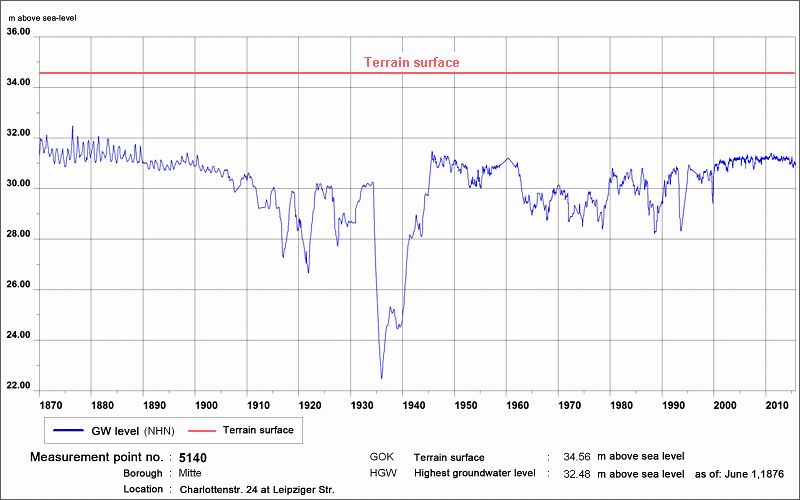The Berlin groundwater measurement network grew rapidly: Thus, by 1937, there were already more than 2000 measurement points. At present, following an optimization of the measurement network in the city, the State Groundwater Service operates approx. 1000 measurement points which are installed at the five different aquifers.
In the inner-city area too, which is not within the area affected by the waterworks, groundwater conditions have for over 100 years been strongly anthropogenically overformed. This can be shown by way of the example of the hydrographic curve of groundwater levels at Measurement Point 5140 (Figure 9) in the borough of Mitte, as follows:
Until 1890, the largely natural seasonal fluctuations of the groundwater level remained apparent. With the growth of the city, increased impervious coverage, and the construction of small wells for drinking water, the amplitude was reduced, and the groundwater level had, by 1905, been moderately lowered. Thereafter, the large water retention operations connected with major construction sites such as the underground/ subway and the urban rail lines (S-Bahn), as well as the construction of the Reichsbank (today, the Foreign Ministry) and bunkers, etc., with their deep cellars reduced the level of the groundwater by another 10 m over a large area. In 1945, at the time of the collapse after the Second World War, the groundwater level quickly rose back almost to its original level. During the years of reconstruction, it was then repeatedly lowered again. Since the termination of major construction projects with groundwater retention, the groundwater is now back to a high level, and
major precipitation events rapidly lead to a short-term rise in the level. Here, as in other areas of the city, this causes water damage in buildings which have not been sealed against the maximum expected groundwater levels.
The groundwater measurement points are now equipped with automatic data loggers, and provide daily measurements. The data base now contains more than 10 million measured values.
In addition, the Berlin Water Utility and the Brandenburg State Environmental Agency as well as other waterworks operators in Brandenburg provide groundwater level measurement data for the Berlin area and the surrounding areas, for the most part monthly. If the groundwater has a direct connection to surface water (effluent situation, Fig. 4a), additional level data from surface-water measurement points are used.
The present map incorporates measurements from 1666 groundwater measurement points and 25 surface-water measurement points for the main aquifer (Aquifer 2), and from 49 groundwater measurement points and six surface-water measurement points for the Panke Valley groundwater aquifer (Aquifer 1) on the Barnim plateau. At the measurement points which are measured daily, the value of May 15, 2014 was used; for the others, the value taken during the month of May which was closest to this date was used.
The distribution of the measurement points is irregular: The measurement network is densest in the city centre and in the immediate intake areas of the waterworks, and less dense at the outskirts of the city, especially in the surrounding areas in Brandenburg.

